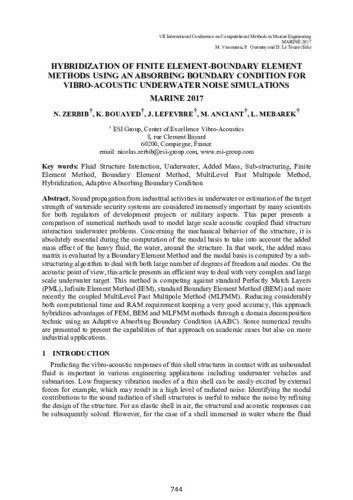Mostra el registre d'ítem simple
Hybridization of finite element-boundary element me hods using an absorbing boundary condition for vibro-acoustic underwater noise simulations
| dc.contributor.author | Zerbib, N. |
| dc.contributor.author | Bouayed, K. |
| dc.contributor.author | Lefevbre, J. |
| dc.contributor.author | Anciant, M. |
| dc.contributor.author | Mebarek, L. |
| dc.date.accessioned | 2020-11-12T13:26:28Z |
| dc.date.available | 2020-11-12T13:26:28Z |
| dc.date.created | 2017 |
| dc.date.issued | 2017 |
| dc.identifier.citation | Zerbib, N. [et al.]. Hybridization of finite element-boundary element me hods using an absorbing boundary condition for vibro-acoustic underwater noise simulations. A: MARINE VII. "MARINE VII : proceedings of the VII International Conference on Computational Methods in Marine Engineering". CIMNE, 2017, p. 744-764. ISBN 978-84-946909-8-3. |
| dc.identifier.isbn | 978-84-946909-8-3 |
| dc.identifier.uri | http://hdl.handle.net/2117/332041 |
| dc.description.abstract | Sound propagation from industrial activities in underwater or estimation of the target strength o waterside security systems are considered immensely important by many scientists for both regulators of development projects or military aspects. This paper presents a comparison of numerical methods used to model large scale acoustic coupled fluid structure interaction underwater problems. Concerning the mechanical behavior of the structure, it is absolutely essential during the computation of the modal basis to take into account the added mass effect of the heavy fluid, the water, around the structure. In that work, the added mass matrix is evaluated by a Boundary Element Method and the modal basis is computed by a sub- structuring algorithm to deal with both large number of degrees of freedom and modes. On the acoustic point of view, this article presents an efficient way to deal with very complex and large scale underwater target. This method is competing against standard Perfectly Match Layers (PML), Infinite Element Method (IEM), standard Boundary Element Method (BEM) and more recently the coupled MultiLevel Fast Multipole Method (MLFMM). Reducing considerably both computational time and RAM requirement keeping a very good accuracy, this approach hybridizes advantages of FEM, BEM and MLFMM methods through a domain decomposition technic using an Adaptive Absorbing Boundary Condition (AABC). Some numerical results are presented to present the capabilities of that approach on academic cases but also on more industrial applications. |
| dc.format.extent | 21 p. |
| dc.language.iso | eng |
| dc.publisher | CIMNE |
| dc.rights | Open access |
| dc.subject | Àrees temàtiques de la UPC::Matemàtiques i estadística::Anàlisi numèrica::Mètodes en elements finits |
| dc.subject.lcsh | Finite element method |
| dc.subject.lcsh | Marine engineering |
| dc.subject.other | Key words: Fluid Structure Interaction, Underwater, Added Mass, Sub-structuring, Finite Element Method, Boundary Element Method, MultiLevel Fast Multipole Method, Hybridization, Adaptive Absorbing Boundary Condition |
| dc.title | Hybridization of finite element-boundary element me hods using an absorbing boundary condition for vibro-acoustic underwater noise simulations |
| dc.type | Conference report |
| dc.subject.lemac | Enginyeria naval |
| dc.rights.access | Open Access |
| local.citation.contributor | MARINE VII |
| local.citation.publicationName | MARINE VII : proceedings of the VII International Conference on Computational Methods in Marine Engineering |
| local.citation.startingPage | 744 |
| local.citation.endingPage | 764 |


